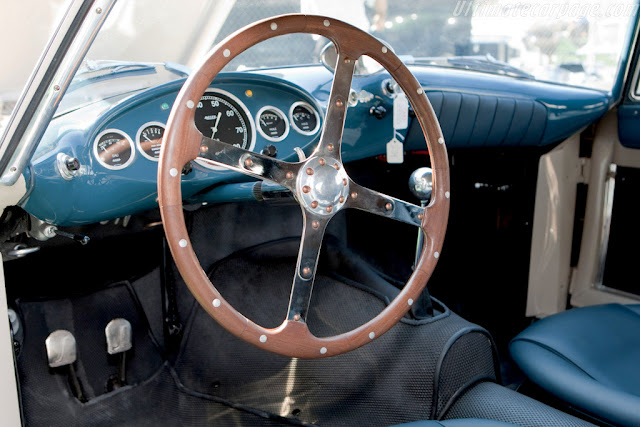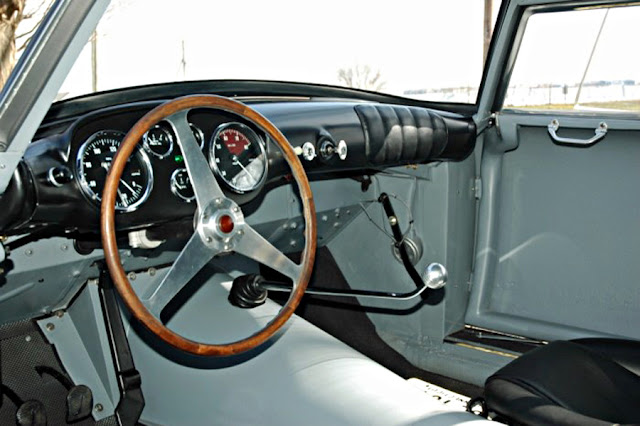The Siata 208 CS is an Italian sports car produced by Siata. Introduced in 1952, it is the coupe counterpart to the sports spider Siata 208s released that same year.
Turin-based like Fiat, Siata had a longstanding relationship with Italy's largest automobile manufacturer, dating back to its founding in 1926. Siata made a name for itself hot-rodding Fiats, producing twin-carb intakes, alloy high-compression cylinder heads, overhead-valve conversions for side-valve engines, altered gearsets, four- and five-speed gearboxes and even superchargers.
After building 114 examples of the Otto Vu, Fiat decided to return to its forte of economical family cars. With less than 200 engines made, Fiat turned over a large portion of the remaining powerplants to Siata, which had helped Fiat engineer and build the prototype 8V chassis in the first place.
Siata's first act with its stash of 8V engines was to create the 208 S, a sublime roadster with a body from Carrozzeria Motto. Beyond the 35 roadsters produced and a handful of prototypes, Siata also built 18 competition coupes 208 CS, the first seven of which came from Stabilimenti Farina. At least one of the Farina bodied cars built was a convertible/spyder model. Upon that coachbuilder's demise in 1953, Siata turned to Carrozzeria Balbo for the final run of 11. A handful of these 11 were badged as "200 CS" while the rest were "208 CS".
Though the two coupes from Stabilimenti Farina and Balbo are similar in design, there are subtle differences, most notably in the slightly lower profile overall and the front-end treatment, the earlier, Farina-built cars, they have a rather toothy, protruding grille that gave way to a more subdued one in the Balbo cars.
The 208 CS is powered by a tuned version of the Fiat "Otto Vu" engine, a 1,996 CC OHV Alloy 70 ̊ V-8, used in the Fiat 8V. In the 208 CS, though Siata quotes a figure of 110 hp (82 kW), actual power has been measured to be about 125 hp (93 kW) at 6,000 rpm with twin Weber 36 DCF3 carburetors, and 140 hp (100 kW) using Siata's hotter camshaft and triple Weber Carburetors. (en.wikipedia.org & hemmings.com)
Though the two coupes from Stabilimenti Farina and Balbo are similar in design, there are subtle differences, most notably in the slightly lower profile overall and the front-end treatment, the earlier, Farina-built cars, they have a rather toothy, protruding grille that gave way to a more subdued one in the Balbo cars.
The 208 CS is powered by a tuned version of the Fiat "Otto Vu" engine, a 1,996 CC OHV Alloy 70 ̊ V-8, used in the Fiat 8V. In the 208 CS, though Siata quotes a figure of 110 hp (82 kW), actual power has been measured to be about 125 hp (93 kW) at 6,000 rpm with twin Weber 36 DCF3 carburetors, and 140 hp (100 kW) using Siata's hotter camshaft and triple Weber Carburetors. (en.wikipedia.org & hemmings.com)
Siata 208 CS Stabilimenti Farina Berlinetta (7)
These were slightly lower than the later Balbo bodied cars thanks to pinched chassis rails that allowed the seat to be fitted lower in the chassis. (alfistas.es)
Chassis: CS052 (1952)
The first car, chassis CS052, debuted at the 1952 Torino Auto Show. Stabilimenti Farina designed and executed the body which was exceptionally low. The design used retractable headlights, a wrap around windshield and small side windows. One of the Farina bodied cars built was a convertible/spyder model. (supercars.net)
Siata 208 CS Balbo Coupe (11)
A handful of these were badged as "200 CS" while the rest were "208 CS". The Balbo chassis compared to the Stabilimenti Farina chassis was different in a way that the seats of the car came located over tubes instead of in between. This made the whole car look higher and it was a bit shorter, therefore no longer looking a sleek as it was. Essentially the design was the same. (alfabb.com)
Chassis: CS061 (1952)
Chassis: CS069 (1953)
Chassis: CS071 (1954)
This one is a Siata 200 CS.
Chassis: CS073 (1954)
Chassis: CS074 (1954)
(Photos from autowp.ru, bonham.com, ultimatecarpage.com,
ruotevecchie.org, favcars.com, conceptcarz.com, hemmings.com






































































































































